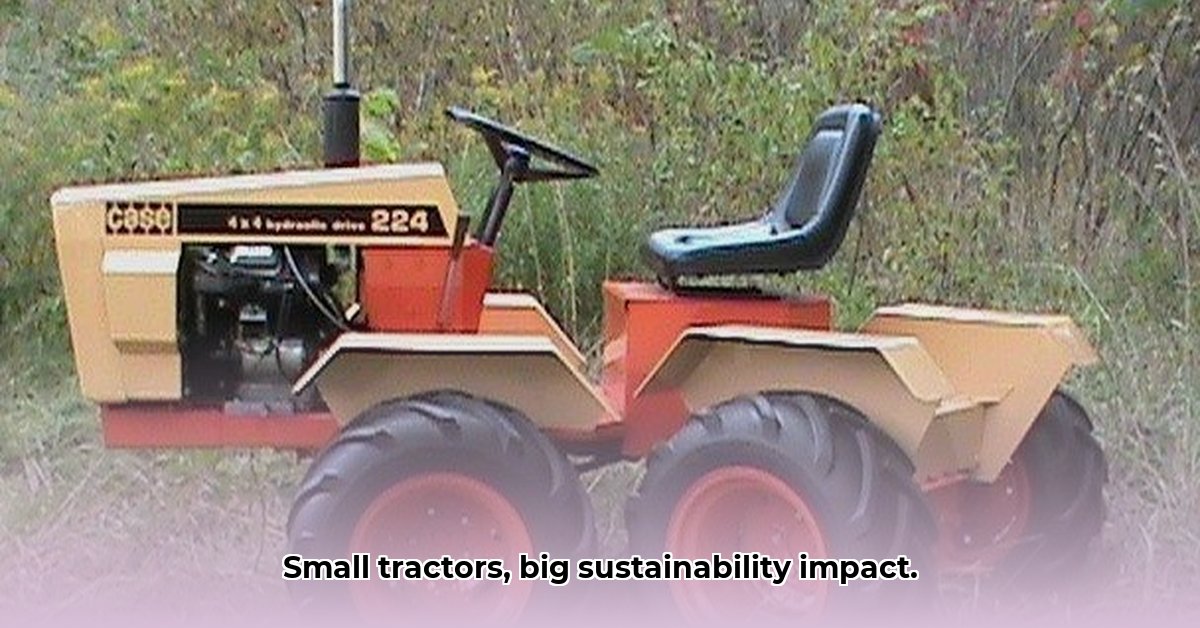
Small Articulated Tractors: A Revolution in Sustainable Agriculture
Sustainable farming practices demand efficiency and minimal environmental impact. Small articulated tractors, particularly models like the Bobcat AT450, are emerging as a potent solution for farmers seeking to optimize their operations while preserving soil health. These tractors offer unique advantages stemming from their compact size and innovative design, but potential drawbacks, primarily concerning initial cost and payload capacity, require careful consideration. For DIY enthusiasts, check out this homemade articulating tractor project. This article will provide a comprehensive analysis of the Bobcat AT450's capabilities, exploring its benefits and limitations within the context of sustainable agriculture, and ultimately guiding farmers toward informed decision-making.
Technical Specifications and Capabilities of the Bobcat AT450
The Bobcat AT450's defining feature is its articulated steering system. This allows the tractor to pivot in the middle, enabling exceptional maneuverability in confined spaces like vineyards and orchards. This agility significantly reduces soil compaction compared to conventional tractors, a crucial aspect of sustainable farming. The AT450's Quick-Hitch™ system allows for rapid attachment changes, facilitating year-round versatility. This system supports a wide array of implements, including mowers, snow plows, and various tillage tools, maximizing equipment utilization and minimizing idle time. A spacious cab enhances operator comfort, contributing to increased productivity and reduced operator fatigue. While specific power, ground clearance, and lifting capacity details are best found on the manufacturer's website 1, the AT450's design is optimized for efficient operation in diverse terrains and seasonal tasks. Isn't maximizing operational efficiency a key goal of sustainable farming?
Advantages in Sustainable Agriculture
The Bobcat AT450 directly addresses several challenges faced by modern sustainable farming. Its compact size and precise turning radius minimize soil disturbance, promoting soil health and reducing the negative environmental impacts of heavy machinery. The year-round versatility, enabled by the Quick-Hitch™ system, extends the working season and increases return on investment. The improved operator comfort contributes to higher productivity and better farm management. Furthermore, the potential for fuel efficiency gains (depending on specific usage and comparison points) is in line with sustainable agriculture's focus on reduced resource dependence. This makes the AT450 a compelling option for small-scale farms aiming for greater productivity while adhering to sustainable principles.
Limitations and Economic Considerations
Despite its advantages, the high initial purchase price of the Bobcat AT450 is a significant factor to consider. This initial investment, coupled with potential maintenance and repair costs, requires careful financial analysis. The tractor's relatively limited payload capacity compared to larger tractors might restrict its suitability for certain tasks or larger-scale operations. A thorough cost-benefit analysis, including factors like depreciation, fuel costs, and labor savings, is crucial in determining the economic viability of purchasing the AT450. This analysis should be tailored to specific farm characteristics and operational needs; a crucial step for responsible investment. Does a comprehensive financial evaluation align with your sustainable farming strategy?
Actionable Recommendations for Stakeholders
To maximize the benefits and mitigate the risks associated with the Bobcat AT450, actionable steps are needed across different stakeholders:
Small-Scale Farmers: Explore leasing options to reduce upfront costs and investigate government subsidies or grants for sustainable farming technologies. Carefully conduct a ROI analysis, considering the time horizon relevant to your farming plan.
Large-Scale Farmers: Integrate the AT450 into your existing fleet for specialized tasks (e.g., vineyard management, orchard work), leveraging its maneuverability in restricted spaces. Don't expect it to replace all your existing machinery.
Equipment Dealers: Offer flexible financing and comprehensive operator training programs to enhance customer access and utilization. Promote attachment packages tailored to sustainable farming practices.
Researchers: Conduct comparative studies on fuel efficiency, soil compaction, and the overall environmental impact of small articulated tractors compared to traditional farming equipment. Explore alternative fuel technologies for further sustainability improvements.
Conclusion: Navigating the Path to Sustainable Farming with the Bobcat AT450
The Bobcat AT450 presents a compelling solution for farmers seeking to integrate sustainable practices into their operations. Its maneuverability, versatility, and operator-friendly design offer significant advantages in specific farming contexts. However, the high initial cost and limited payload capacity necessitate a thorough assessment of its suitability for individual farms. By carefully weighing the advantages against the economic considerations and following a structured decision-making process, farmers can determine whether the Bobcat AT450 aligns with their long-term sustainability goals and financial viability. Remember, planning is paramount in achieving responsible and profitable sustainable farming.